九年级英语下册 Chapter 5 Family lives课件 上海牛津版
- 格式:ppt
- 大小:5.06 MB
- 文档页数:7
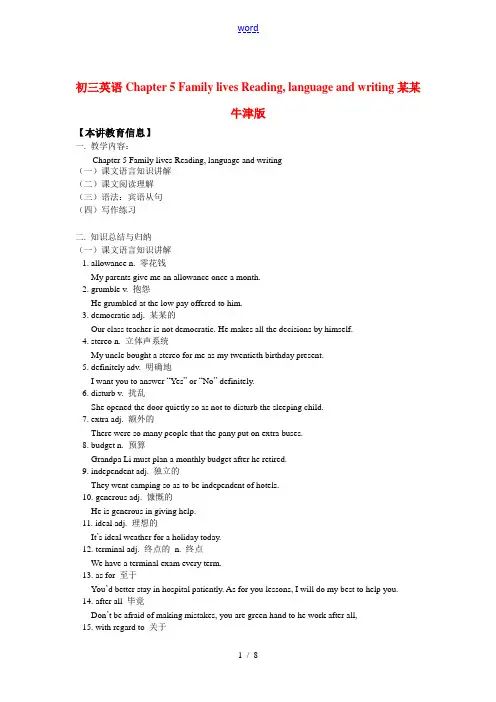
初三英语Chapter 5 Family lives Reading, language and writing某某牛津版【本讲教育信息】一. 教学内容:Chapter 5 Family lives Reading, language and writing(一)课文语言知识讲解(二)课文阅读理解(三)语法:宾语从句(四)写作练习二. 知识总结与归纳(一)课文语言知识讲解1. allowance n. 零花钱My parents give me an allowance once a month.2. grumble v. 抱怨He grumbled at the low pay offered to him.3. democratic adj. 某某的Our class teacher is not democratic. He makes all the decisions by himself.4. stereo n. 立体声系统My uncle bought a stereo for me as my twentieth birthday present.5. definitely adv. 明确地I want you to answer “Yes” or “No” definitely.6. disturb v. 扰乱She opened the door quietly so as not to disturb the sleeping child.7. extra adj. 额外的There were so many people that the pany put on extra buses.8. budget n. 预算Grandpa Li must plan a monthly budget after he retired.9. independent adj. 独立的They went camping so as to be independent of hotels.10. generous adj. 慷慨的He is generous in giving help.11. ideal adj. 理想的It’s ideal weather for a holiday today.12. terminal adj. 终点的n. 终点We have a terminal exam every term.13. as for 至于You’d better stay in hospital patiently. As for you lessons, I will do my best to help you. 14. after all 毕竟Don’t be afraid of making mistakes, you are green hand to he work after all,15. with regard to 关于With regard to this problem, we should work out a solution at once.16. pay for 偿还You must pay for what you eat and drink.(二)课文阅读理解P60 A Look and thinkB Find the factsC Find the meaningsC1C2D Read and think(三)语法:宾语从句引导词的使用1. 当宾语从句由陈述句变化而来时,用that来引导从句,that常无具体意义,一般可省略。
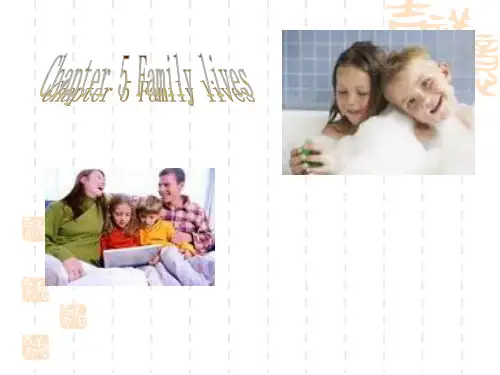
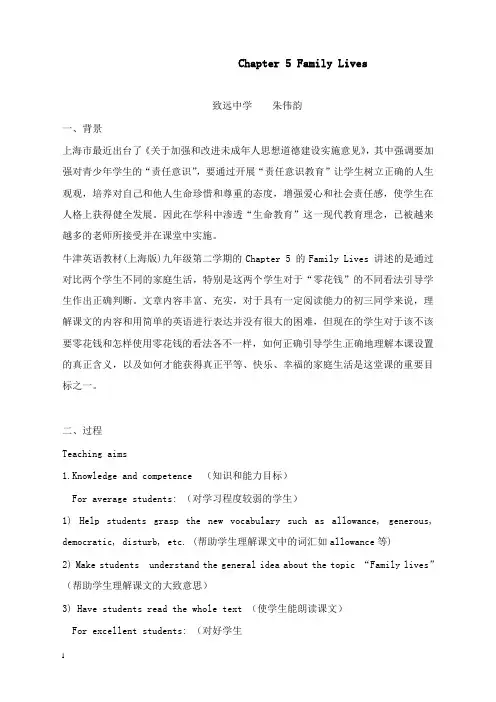
Chapter 5 Family Lives致远中学朱伟韵一、背景上海市最近出台了《关于加强和改进未成年人思想道德建设实施意见》,其中强调要加强对青少年学生的“责任意识”,要通过开展“责任意识教育”让学生树立正确的人生观观,培养对自己和他人生命珍惜和尊重的态度,增强爱心和社会责任感,使学生在人格上获得健全发展。
因此在学科中渗透“生命教育”这一现代教育理念,已被越来越多的老师所接受并在课堂中实施。
牛津英语教材(上海版)九年级第二学期的Chapter 5 的Family Lives 讲述的是通过对比两个学生不同的家庭生活,特别是这两个学生对于“零花钱”的不同看法引导学生作出正确判断。
文章内容丰富、充实,对于具有一定阅读能力的初三同学来说,理解课文的内容和用简单的英语进行表达并没有很大的困难,但现在的学生对于该不该要零花钱和怎样使用零花钱的看法各不一样,如何正确引导学生正确地理解本课设置的真正含义,以及如何才能获得真正平等、快乐、幸福的家庭生活是这堂课的重要目标之一。
二、过程Teaching aims1.Knowledge and competence (知识和能力目标)For average students: (对学习程度较弱的学生)1) Help students grasp the new vocabulary such as allowance, generous, democratic, disturb, etc. (帮助学生理解课文中的词汇如allowance等)2) Make students understand the general idea about the topic “Family lives”(帮助学生理解课文的大致意思)3) Have students read the whole text (使学生能朗读课文)For excellent students: (对好学生1) Have students to develop the listening and reading skills (understanding and processing the information in the reading materials) (培养学生的听力和阅读及在阅读中获取信息的能力)2) Make students learn more about family lives ,and encourage them to say something more about their own family lives(使学生了解更多有关家庭生活方面的内容并鼓励学生用所学的词汇说出他们自己的家庭生活情况)3) Have students to think more deeply about what they have read (使学生对所学内容有进一步的理解)2.Process and approaches (过程和方法)1)Train the students’listening ability and help them catch some key words to guess the meaning of the sentences and understand the general idea of the passages (能在听中克服生词障碍,理解大意,获取准确信息)2) Train the students speaking ability by answering the questions on the text and discussing some topics. Make students able to express their own ideas in simple English (通过回答问题和小组讨论培养学生开口说话的能力, 并能用简单的语言表达自己的思想和观点)3) Train students’reading ability of the text and also help them to read some relevant materials for specific information (能正确流畅地朗读课文,能在阅读中运用阅读策略获取所需的信息.)4) Train students’writing ability by gathering and sharing information, ideas in each paragraph. To help them write composition about the topic (能从文章中获取主要信息,并能写出有关这一主题的文章)3. Emotion , attitude and value evaluation (情感、态度和价值观)1) To arouse the students’interest in learning English(激发学生学习英语的兴趣)2) To make the students take part in English communicative activities willingly (积极参与课堂活动)3) To help the students learn to cooperate with their classmates and accomplish their tasks together (培养学生的合作和团队精神)4) To encourage the students to solve the problems by dealing with the related information found by themselves. (鼓励学生自己提出问题和解决问题的能力Language focus: (教学重点)Make the students know the main four aspects of one’s family lives and make them be able to talk freely about them.Language difficulties: (教学难点)Require the students to say some other aspects of one’s family lives and to make dialoguesabout the topic.Teagprocedures:(教学过程)Read thethe studentshow the Ss aShow the Ss a教学反思:在课堂教学中教师必须把学生作为一个鲜活的生命个体来看待,促进学生的发展,宽容个体差异,应使学生始终处于被激励的气氛中,让他们在课堂中焕发出生命的活力。
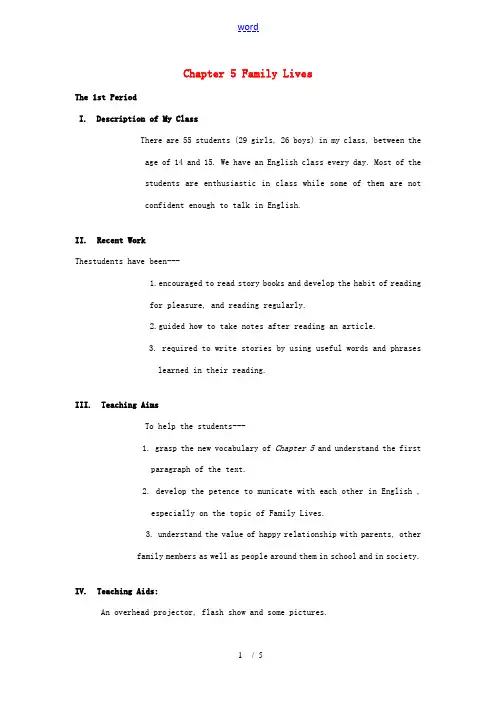
Chapter 5 Family LivesThe 1st PeriodI. Description of My ClassThere are 55 students (29 girls, 26 boys) in my class, between the age of 14 and 15. We have an English class every day. Most of thestudents are enthusiastic in class while some of them are notconfident enough to talk in English.II. Recent WorkThestudents have been---1.encouraged to read story books and develop the habit of readingfor pleasure, and reading regularly.2.guided how to take notes after reading an article.3. required to write stories by using useful words and phraseslearned in their reading.III. Teaching AimsTo help the students---1. grasp the new vocabulary of Chapter 5 and understand the firstparagraph of the text.2. develop the petence to municate with each other in English ,especially on the topic of Family Lives.3. understand the value of happy relationship with parents, otherfamily members as well as people around them in school and in society.IV. Teaching Aids:An overhead projector, flash show and some pictures.V. Contents and proceduresTask OneWarming-up ( get ready for class and lead in Chapter 5)Task TwoLearning the key vocabularies of Chapter 5. ( after all, throw away, allowance, series, teenager)Step 1Students are to answer some questions, each of which refers to one of the vocabulary items. And then students are required to guess the word in thesentence.Step 2Students are to match the new words which are taken out of the text of Chapter Five on the screen.Step 3Students are to match the clauses on the basis of understanding.Step 4Students are to say something about a short story by using these new words.Possible problems in fulfilling the task:a. Students may not be sure about the meanings of each vocabulary at first,and may not understand the requirements well. So clear instructions shouldbe given to them.b. Students may need a few seconds to think over before fulfilling the tasks,and it is quite natural that they make some errors while practicing. If necessary, the teacher may point out and correct the errors or let thestudents help one another.Task ThreeLearning the cognition vocabularies of Chapter 5. (generous, grumble, democratic, on end, disturb)Step 1Students are to listen to the text about family life.Step 2Students are to scan the text, and guess the meanings of the new vocabularies according to the context.Step 3Students are to paraphrase the words and phrases in the textPossible problems in fulfilling the task:Students may have difficulty in making out the meanings of the words and phrases. Thus words and phrases with similar meanings or some helpful descriptions should be given.Task FourPracticing the vocabularies through learning and understanding the text.Step 1Listen to the tape and read after it, and then answer the questions about the text.Step 2Students ask and answer questions to each other, and then make a list of items about Tina’s family life.Step 3Say something about Tina’s family life (retell the text).Possible problems in fulfilling the task:The students may find it difficult to ask and answer questions quickly. So enough time should be given.Task Five (Whether to carry out this task depends on how the whole procedure goes.)Authentic Practice: Interviewing a classmate about his/her family life.Step 1Students interview his partner about his/her family life , using the table of Tina’s family life as a model.Step 2Fulfilling an exercise sheet.Possible problems in fulfilling the task:1. Students may have difficulty asking each other for some specificinformation. Thus, a model dialogue will be provided.2. Some students may use the Chinese language while discussing, so theteacher should persuade them try their best not to do so.V. Work after class:1.Read the first paragraph of the text for at least 5 times.2.Write a short passage about your partner’s family life (no less than ?sentences).After you finish writing the passage, read it to your partner. Does he/she agree to your description? If not, make necessary changes.3.Preview the second paragraph of Chapter Five -- Norman’s family life.VI. Post-classEvaluation: A. Have the students learnt the required contents?B. Does the class teaching achieve the goals?C. Do the classroom activities work effectively?D. How can the procedures/activities be improved according to thestudents’ performance in class?E. How can the teacher adjust classroom English according to the understanding levelof the students?。
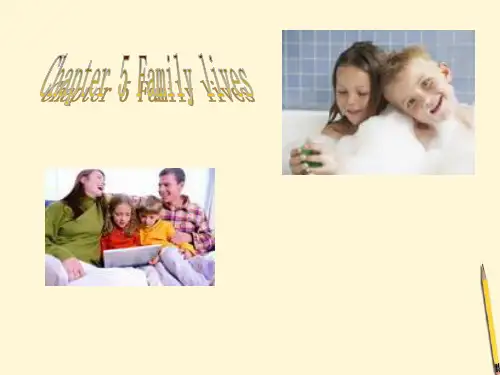
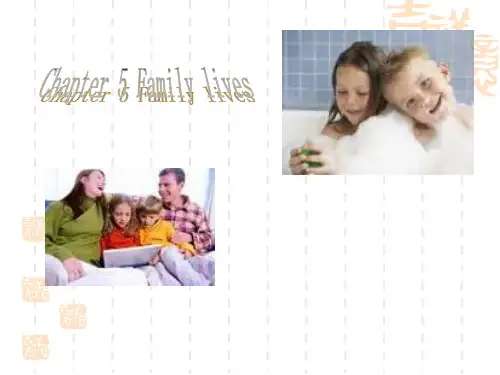


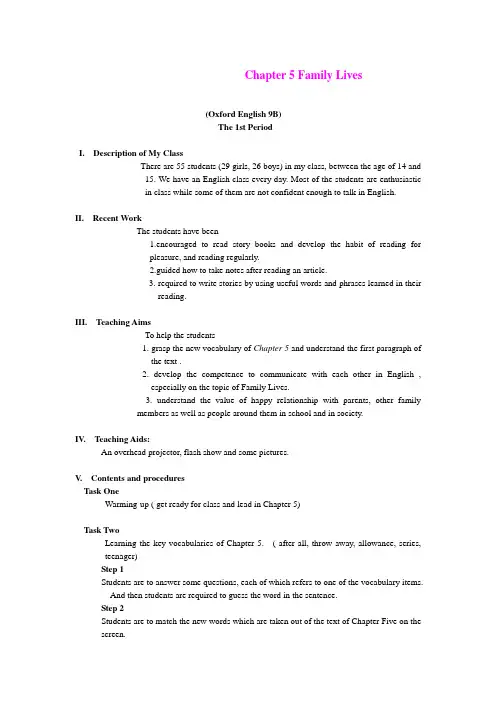
Chapter 5 Family Lives(Oxford English 9B)The 1st PeriodI. Description of My ClassThere are 55 students (29 girls, 26 boys) in my class, between the age of 14 and15. We have an English class every day. Most of the students are enthusiasticin class while some of them are not confident enough to talk in English.II. Recent WorkThe students have been---1.encouraged to read story books and develop the habit of reading forpleasure, and reading regularly.2.guided how to take notes after reading an article.3. required to write stories by using useful words and phrases learned in theirreading.III. Teaching AimsTo help the students---1. grasp the new vocabulary of Chapter 5 and understand the first paragraph ofthe text.2. develop the competence to communicate with each other in English ,especially on the topic of Family Lives.3. understand the value of happy relationship with parents, other familymembers as well as people around them in school and in society.IV. Teaching Aids:An overhead projector, flash show and some pictures.V. Contents and proceduresTask OneWarming-up ( get ready for class and lead in Chapter 5)Task TwoLearning the key vocabularies of Chapter 5. ( after all, throw away, allowance, series, teenager)Step 1Students are to answer some questions, each of which refers to one of the vocabulary items.And then students are required to guess the word in the sentence.Step 2Students are to match the new words which are taken out of the text of Chapter Five on the screen.Step 3Students are to match the clauses on the basis of understanding.Step 4Students are to say something about a short story by using these new words.Possible problems in fulfilling the task:a. Students may not be sure about the meanings of each vocabulary at first, and may notunderstand the requirements well. So clear instructions should be given to them.b. Students may need a few seconds to think over before fulfilling the tasks, and it is quitenatural that they make some errors while practicing. If necessary, the teacher may point out and correct the errors or let the students help one another.Task ThreeLearning the cognition vocabularies of Chapter 5. (generous, grumble, democratic, on end, disturb)Step 1Students are to listen to the text about family life.Step 2Students are to scan the text, and guess the meanings of the new vocabularies according to the context.Step 3Students are to paraphrase the words and phrases in the textPossible problems in fulfilling the task:Students may have difficulty in making out the meanings of the words and phrases. Thus words and phrases with similar meanings or some helpful descriptions should be given.Task FourPracticing the vocabularies through learning and understanding the text.Step 1Listen to the tape and read after it, and then answer the questions about the text.Step 2Students ask and answer questions to each other, and then make a list of items about Tin a’s family life.Step 3Say something about Tina’s family life (retell the text).Possible problems in fulfilling the task:The students may find it difficult to ask and answer questions quickly. So enough time should be given.Task Five (Whether to carry out this task depends on how the whole procedure goes.) Authentic Practice: Interviewing a classmate about his/her family life.Step 1Students interview his partner about his/her family life , using the table of Tina’s familylife as a model.Step 2Fulfilling an exercise sheet.Possible problems in fulfilling the task:1. Students may have difficulty asking each other for some specific information. Thus,a model dialogue will be provided.2. Some students may use the Chinese language while discussing, so the teacher shouldpersuade them try their best not to do so.V. Work after class:1.Read the first paragraph of the text for at least 5 times.2.Write a short passage about your partner’s family life (no less than ? sentences). After youfinish writing the passage, read it to your partner. Does he/she agree to your description? If not, make necessary changes.3.Preview the second paragraph of Chapter Five -- Norman’s family life.VI. Post-classEvaluation: A. Have the students learnt the required contents?B. Does the class teaching achieve the goals?C. Do the classroom activities work effectively?D. How can the procedures/activities be improved according to the students’performance in class?E. How can the teacher adjust classroom English according to theunderstanding level of the students?。
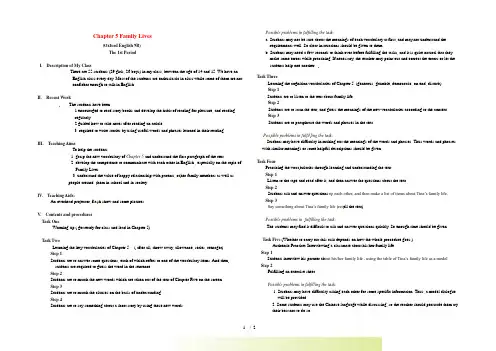
Chapter 5 Family Lives(Oxford English 9B)The 1st PeriodI. Description of My ClassThere are 55 students (29 girls, 26 boys) in my class, between the age of 14 and 15. We have anEnglish class every day. Most of the students are enthusiastic in class while some of them are notconfident enough to talk in English.II. Recent WorkThe students have been---1.encouraged to read story books and develop the habit of reading for pleasure, and readingregularly.2.guided how to take notes after reading an article.3. required to write stories by using useful words and phrases learned in their reading.III. Teaching AimsTo help the students---1. grasp the new vocabulary of Chapter 5 and understand the first paragraph of the text.2. develop the competence to communicate with each other in English , especially on the topic ofFamily Lives.3. understand the value of happy relationship with parents, ot her family members as well aspeople around them in school and in society.IV. Teaching Aids:An overhead projector, fla sh show and some pictures.V. Contents and proceduresTask OneWarming-up ( get ready for class and lead in Chapter 5)Task TwoLearning the ke y vocabularies of Chapter 5. ( after all, throw away, allowance, series, teenager)Step 1Students are to answer some questions, each of which refers to one of the vocabulary items. And thenstudents are required to guess the word in the sentence.Step 2Students are to match the new words which are taken out of the text of Chapter Five on the screen.Step 3Students are to match the clauses on the basis of understanding.Step 4Students are to say something about a short story by using these new words.Possible problems in fulfilling the task:a. Students may not be sure about the meanings of each vocabulary at first, and may not understand therequirements well. So clear instructions should be given to them.b. Students may need a few seconds to think over before fulfilling the tasks, and it is quite natural that theymake some errors while practicing. If necessary, the teacher may point out and correct the errors or let the students help one another.Task ThreeLearning the cognition vocabularies of Chapter 5. (generous, grumble, democratic, on end, disturb)Step 1Students are to listen to the text about family life.Step 2Students are to scan the text, and guess the meanings of the new vocabularies according to the context.Step 3Students are to paraphrase the words and phrases in the textPos sible problems in fulfil ling the task:Students may have difficulty in making out the meanings of the words and phrases. Thus words and phrases with similar meanings or some helpful descriptions should be given.Task FourPracticing the voca bularies through learning and understanding the text.Step 1Listen to the tape and read after it, and then answer the questions about the text.Step 2Students ask and answer questions t o each other, and then make a list of items about Tina’s family life.Step 3Say something about Tina’s family life (ret ell the text).Possible problems in fulfilling the task:The students may find it difficult to ask and answer questions quickly. So enough time should be given.Task Five (Whether to carry out this task depends on how the whole procedure goes.)Authentic Practice: Interviewing a classmate about his/her family life.Step 1Students interview his partner ab out his/her family life , using the table of Tina’s family life as a model. Step 2Fulfilling an exercise sheet.Possible problems in fulfilling the task:1. Students may have difficulty asking each other for some specific information. Thus, a model dialoguewill be provided.2. Some students may use the Chinese language while discussing, so the teacher should persuade them trytheir best not to do so.V. Work after class:1.Read the first paragraph of the text for at least 5 times.2.Write a shor t passage about your partner’s family life (no less than ? sentences). After you finish writing thepassage, read it to your partner. Does he/she agree to your description? If not, make necessary changes.3.Preview the second paragraph of Chapter Five -- Norman’s family life.VI. Post-classEvaluation: A. Have the students learnt the required contents?B. Does the class tea ching achieve the goals?C. Do the classroom activities work effectively?D. How can the procedures/activities be improved according to the students’ performance inclass?E. How can the teacher adjust classroom English according to the understanding level of thestudents?。
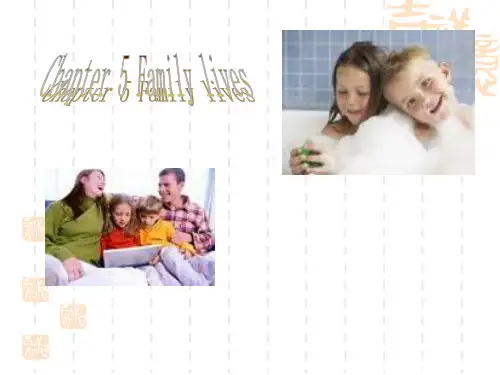
Chapter 5 Family Lives(Oxford English 9B)The 1st PeriodI. Description of My ClassThere are 55 students (29 girls, 26 boys) in my class, between the age of 14 and 15. We have anEnglish class every day. Most of the students are enthusiastic in class while some of them are notconfident enough to talk in English.II. Recent WorkThe students have been---1.encouraged to read story books and develop the habit of reading for pleasure, and readingregularly.2.guided how to take notes after reading an article.3. required to write stories by using useful words and phrases learned in their reading.III. Teaching AimsTo help the students---1. grasp the new vocabulary of Chapter 5 and understand the first paragraph of the text.2. develop the competence to communicate with each other in English , especially on the topic ofFamily Lives.3. understand the value of happy relationship with parents, other family members as well aspeople around them in school and in society.IV. Teaching Aids:An overhead projector, flash show and some pictures.V. Contents and proceduresTask OneWarming-up ( get ready for class and lead in Chapter 5)Task TwoLearning the key vocabularies of Chapter 5. ( after all, throw away, allowance, series, teenager)Step 1Students are to answer some questions, each of which refers to one of the vocabulary items. And then students are required to guess the word in the sentence.Step 2Students are to match the new words which are taken out of the text of Chapter Five on the screen.Step 3Students are to match the clauses on the basis of understanding.Step 4Students are to say something about a short story by using these new words.Possible problems in fulfilling the task:a. Students may not be sure about the meanings of each vocabulary at first, and may not understand therequirements well. So clear instructions should be given to them.b. Students may need a few seconds to think over before fulfilling the tasks, and it is quite natural that theymake some errors while practicing. If necessary, the teacher may point out and correct the errors or let the students help one another.Task ThreeLearning the cognition vocabularies of Chapter 5. (generous, grumble, democratic, on end, disturb)Step 1Students are to listen to the text about family life.Step 2Students are to scan the text, and guess the meanings of the new vocabularies according to the context.Step 3Students are to paraphrase the words and phrases in the textPossible problems in fulfilling the task:Students may have difficulty in making out the meanings of the words and phrases. Thus words and phrases with similar meanings or some helpful descriptions should be given.Task FourPracticing the vocabularies through learning and understanding the text.Step 1Listen to the tape and read after it, and then answer the questions about the text.Step 2Students ask and answer questions to each other, and then make a list of items about Tina’s family life.Step 3Say something about Tina’s family life (retell the text).Possible problems in fulfilling the task:The students may find it difficult to ask and answer questions quickly. So enough time should be given.Task Five (Whether to carry out this task depends on how the whole procedure goes.)Authentic Practice: Interviewing a classmate about his/her family life.Step 1Students interview his partner about his/her family life , using the table of Tina’s family life as a model. Step 2Fulfilling an exercise sheet.Possible problems in fulfilling the task:1. Students may have difficulty asking each other for some specific information. Thus, a model dialoguewill be provided.2. Some students may use the Chinese language while discussing, so the teacher should persuade them trytheir best not to do so.V. Work after class:1.Read the first paragraph of the text for at least 5 times.2.Write a short passage about your partner’s family life (no less than ? sentences). After you finish writing thepassage, read it to your partner. Does he/she agree to your description? If not, make necessary changes.3.Preview the second paragraph of Chapter Five -- Norman’s family life.VI. Post-classEvaluation: A. Have the students learnt the required contents?B. Does the class teaching achieve the goals?C. Do the classroom activities work effectively?D. How can the procedures/activities be improved according to the students’ performance inclass?E. How can the teacher adjust classroom English according to the understanding level of thestudents?。